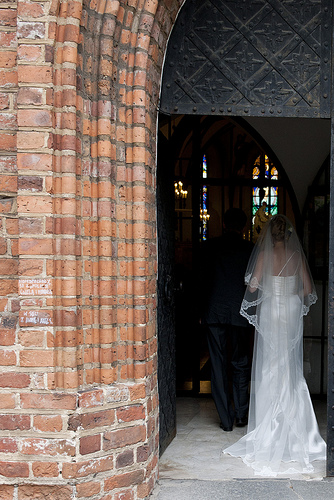Preparing Your Wedding Liturgy
A walk through the liturgy: Entrance Procession

Preparing your Wedding Liturgy
- Introduction & Starting Points
- A Walkthrough the Liturgy
- Marriage Texts
- Choosing Readings
- Choosing Music
- Further Choices
Description
The wedding begins with a procession, in a way that many Church services do. In England and Wales we are used to the Bridal Procession, where the Bride on the arm of her father walks up the aisle followed by bridesmaids accompanied by the organ or other instrumental music.
In many cultures the procession is made up of everyone who is there: the bride, the groom, families and friends welcomed at the door by the priest and all walk up the aisle together.
Choices
So there are two ways of doing the Entrance Procession: the Bridal procession or all together. Like all parts of the liturgy the way something is done emphasises different meanings. For example, you could contrast the two forms as being about past and future. The Bridal procession is about the bride and the family and home she is moving away from — it is a sign of the past she brings to her new life in marriage. When everyone enters together it is a reminder that through marriage not only do two people become one as equal partners but also that two families are now connected — it is a sign of a new present reality which will deepen in the future
Music
Usually in Church services processions are accompanied by hymns sung by everyone. This is a possibility for the beginning of wedding, however in most circumstances people choose to have music which isn’t sung at this point. A possible reason why people choose this is because the congregation are more likely to look at the procession than to be reading and singing a sung text. The music is often played on the organ but could be played on other instruments. Take care about the length of the music and the length of the procession — a good organist will be able to bring the piece to a suitable conclusion once everyone is in place.
Though it may be unfamiliar it would be quite possible to accompany the procession with singing. There are alternatives to singing hymns where people need to keep their eye on the text. The music of Taizé includes many joyful chants which can be easily be picked up or it may be a piece with a short refrain sung by all and verses sung by a cantor or choir. A further alternative would be for a choir piece to accompany the procession.
Some may wish to use recorded music (if permitted) to accompany the procession if the church has the facilities to do this. You will need to ask someone to operate the equipment — and they will need to do more than just switch the music on and off. There may also be question about whether the music is suitable for use within the liturgy of the Church
